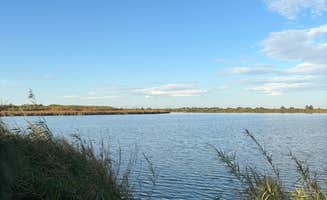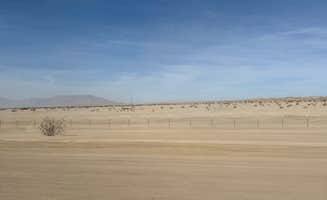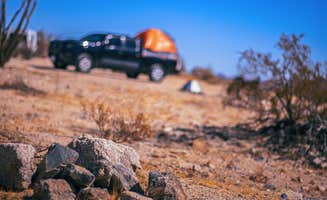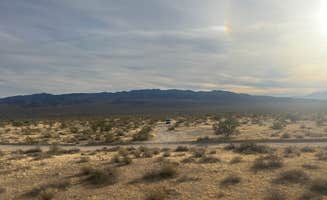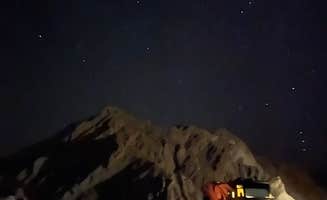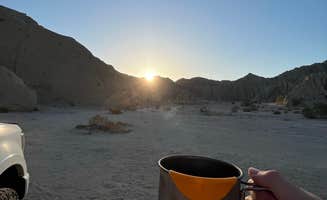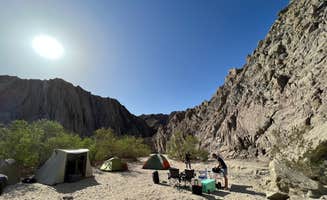Niland sits at an elevation of 131 feet below sea level along the eastern edge of the Salton Sea in Imperial County, California. The surrounding landscape features sandy plains, small hills, and scrub vegetation typical of low desert environments. Daytime temperatures in winter months remain mild, ranging between 65-75°F from November through February, which creates ideal conditions for outdoor recreation.
What to do
Explore desert geology: The Obsidian Butte area near Niland offers interesting volcanic formations to explore. While there are no formal trails, visitors can walk around the dark volcanic glass formations and learn about the region's geologic history.
Visit natural hot springs: Holtville Hot Springs provides thermal soaking options about 25 miles south of Niland. Visitors to Red Hill Marina Park often include this in their itinerary. "Very Primitive location but beautiful in its own right. Gets dusty, tons of birds, close to the Salton Sea and no complaints. $7 per night for a tent site, a little more for hookups," notes Chad F.
Birdwatching opportunities: The wetlands near Finney Lake Camp attract numerous bird species. "Pretty lake, but swarming with flies and a bit of an odor. GPS will try to take you onto the wrong end of Williams Road, you need to go on Titsworth -> Smith -> then Williams," reports Robert S., highlighting both the opportunity and challenges.
What campers like
Dark skies for astronomy: Campers consistently mention excellent stargazing conditions at Joshua Tree South - BLM Dispersed. "Nice area, open enough you don't need to worry vout interacting with or bothering your neighbors if you don't want to. Just be careful of the sandy areas, got dug in with my sprinter and needed someone to pull me out," advises Andy D.
Free camping options: No-cost dispersed camping near Niland provides budget-friendly alternatives. At Joshua Tree South Dispersed, one reviewer shared, "This area is managed by BLM, which means it's free to use for up to 14 days at a time. There are no hookups or facilities, and it's pack it in, pack it out."
Solitude and space: The open desert landscape allows for privacy between campsites. At Niland Marina, one camper noted, "Beautiful spot near the lake with gorgeous views. Nobody as far as the eye could see, of course it's 100 degrees, but I have a trailer and awning with netting."
What you should know
Road conditions vary dramatically: Many access roads consist of soft sand that can trap vehicles without adequate clearance or 4WD. As noted about Redcloud Road Dispersed Camp, "The road is very smooth at least in the beginning of the trail," but conditions can deteriorate farther in.
Water access is limited: Most dispersed camping areas near Niland have no potable water sources. Bring all water needed for drinking, cooking, and cleaning. Plan for at least one gallon per person per day, with extra during warmer months.
Cell service is inconsistent: Coverage varies widely based on terrain and proximity to highways. Joshua Tree South Dispersed Camping has "Great cell signal here, but keep in mind that within Joshua Tree NP there is poor, almost non-existent cell signal," according to one camper.
Desert hazards require preparation: Temperatures can drop dramatically at night, even when days are warm. Wildlife including rattlesnakes, scorpions and other desert creatures may be active, particularly at dawn and dusk. Inspect shoes and gear before use.
Tips for camping with families
Bring multiple shade options: Portable canopies, umbrellas, and tarps are essential for creating cool areas as natural shade is minimal. Have backup cooling methods for when temperatures rise unexpectedly.
Plan early morning activities: Schedule hiking, exploring, and outdoor play before 10 AM when temperatures are cooler. At Truckhaven at Ocotillo Wells State Vehicle Recreation Area, families enjoy the cooler hours for recreation. "Desert camping. Make your campsite anywhere, restrooms near by, driving distance to a few stores & gas station," shares Jenna S.
Pack entertainment options: Board games, card games, and books provide entertainment during hot afternoon hours when outdoor activities may be limited. Bring binoculars for wildlife watching from shaded areas.
Secure all food items: Desert winds can quickly scatter unsecured items, and nighttime visitors like coyotes may investigate food left out. Use heavy containers with secure lids for all food storage.
Tips from RVers
Level carefully: Many dispersed sites have uneven terrain. Bring leveling blocks and take time to position your RV properly. One camper at Joshua Tree South Entrance noted, "It's actually very quiet even though the freeway is close. The trash right off the freeway is so sad, but the actual BLM further in is clean. I was able to get our CTC level and we love our spot."
Map alternative routes: Have paper maps showing multiple access points to camping areas in case primary routes become impassable. GPS systems sometimes route vehicles down unsuitable roads in remote areas.
Check road conditions before committing: Once you turn off paved roads, survey the terrain ahead before proceeding with larger rigs. Several campers report getting stuck when they ventured too far down deteriorating roads.
Conserve resources: With limited access to water and dump stations, practice water conservation and plan trips to facilities in nearby towns. Most campers report needing to drive 20-30 miles for full services.



